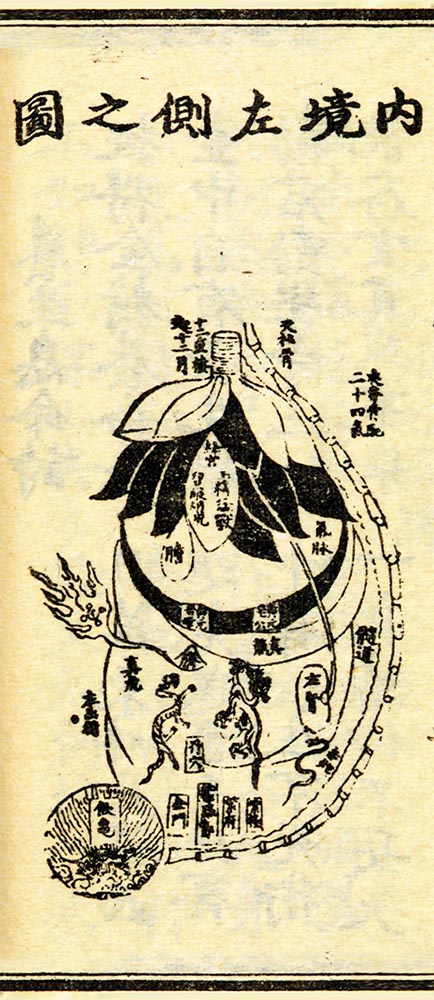Diagram of the Inner Landscape

Diagram of the inner landscape from Zhang Jiebin (1563-1640), Illustrated Wing of the “Classified Canon” (Leijing tuyi), woodblock edition, preface dated 1624. From the collection of the Harvard-Yenching Library, Harvard University – In his magnum opus, The Classified Canon (Leijing), the physician Zhang Jiebin reorganized the contents of the Yellow Emperor’s Inner Canon by topic. […]
Maps of the inner sceneries • ventral and dorsal view

This page is viewed best with a large screen. 1 2 3 4 5 6 7 8 9 10 F ‘Map of the inner sceneries in dorsal view’ (Ti ke ge, 3b) 1 2 3 4 5 6 7 8 9 10 11 12 13 14 15 E ‘Map of the inner sceneries in ventral […]
Maps of the inner sceneries • from the left and the right side

This page is viewed best with a large screen. 1 2 3 4 5 6 7 8 9 10 11 12 13 14 15 16 17 18 19 20 21 22 23 24 D ‘Map of the inner sceneries from the right side’ (Ti ke ge, 3a) 1 2 3 4 5 6 7 8 […]
Master Yan Luo’s head maps • frontal view and southwards looking

This page is viewed best with a large screen. 1 2 3 4 5 6 7 8 9 10 11 B ‘Master Yan Luo’s map of courting the perfected’ (Ti ke ge, 2b) 1 2 3 4 5 6 7 8 9 10 11 12 13 14 15 16 17 18 19 20 21 22 […]
The right kidney as the gate of life

A B The Right kidney as the Gate of life. A No title. The right kidney as the Gate of life. Kajiwara Shōzen 梶原性全 (1265–1337) Man’anpo 万安方, 1315–27, scroll 54. Edo 江戸 period (1603–1868) manuscript. National Archives of Japan. B ‘The Right kidney as the Gate of life governs blood and essence and enters the […]
The Screen gate

A B The Screen gate A No title. The Screen gate. Kajiwara Shōzen 梶原性全 (1265–1337) Man’anpo 万安方, 1315–27, scroll 54. Edo 江戸 period (1603–1868) manuscript. National Archives of Japan. B ‘Illustration of the Screen gate that separates water and grains’, Lanmen shuigu mibie tu 闌門水穀泌別圖. Wang Haogu 王好古 (1200–64?) The Great Teaching of Yi Yin’s Decoction […]
The spleen-stomach system

A B The spleen–stomach system A No title. The spleen-stomach system. Kajiwara Shōzen 梶原性全 (1265–1337) Man’anpo 万安方, 1315–27, scroll 54. Edo 江戸 period (1603–1868) manuscript. National Archives of Japan. B ‘Illustration of the spleen-stomach system’, Piweibao xi tu 脾胃胞系圖. Wang Haogu 王好古 (1200–64?) The Great Teaching of Yi Yin’s Decoction Classic Propagated by [Zhang] Zhongjing, Yi […]
The sea of qi and the diaphragm

A B The sea of qi and the diaphragm A No title. The sea of qi and the diaphragm. Kajiwara Shōzen 梶原性全 (1265–1337) Man’anpo 万安方, 1315–27, scroll 54. Edo 江戸 period (1603–1868) manuscript. National Archives of Japan. B ‘Illustration of the sea of qi and the diaphragm’, Qihai gemo tu 氣海隔膜圖. Wang Haogu 王好古 (1200–64?) […]
Communication of the connectors of the five solid vessels with the heart.

A B Communication of the connectors of the five solid vessels (wu zang) with the heart. A No title. Communication of the connectors of the five solid vessels with the heart. Kajiwara Shōzen 梶原性全 (1265–1337) Man’anpo 万安方, 1315–27, scroll 54. Edo 江戸 period (1603–1868) manuscript. National Archives of Japan. B ‘Illustration of the communication of […]
